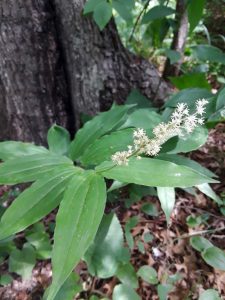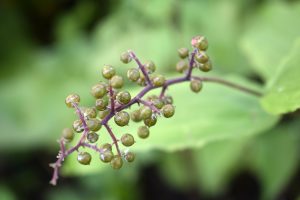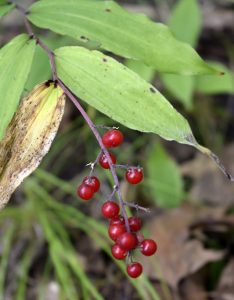False Solomon’s Seal
 Maianthemum racemosum, also called feathery false lily-of-the-valley, is native to many parts of N. America with stems arching at a horizontal angle across their home on the forest floor. Whether rustling in the breeze on the Rocky Mountain forested slopes at high elevation, or adorning our MN woodlands, the familiar pattern of up to 6″ long leaves greets us as they climb up their stems. Leaves show smooth, deeply veined upper surfaces with undersides a bit hairy.
Maianthemum racemosum, also called feathery false lily-of-the-valley, is native to many parts of N. America with stems arching at a horizontal angle across their home on the forest floor. Whether rustling in the breeze on the Rocky Mountain forested slopes at high elevation, or adorning our MN woodlands, the familiar pattern of up to 6″ long leaves greets us as they climb up their stems. Leaves show smooth, deeply veined upper surfaces with undersides a bit hairy.
The stem slightly zigzags its way between the alternately attached leaves until, at its tip, a cluster of fragrant flowers forms in a shower of 20 – 80 individual, 1/4″ blooms. Each star-shaped flower has 6 tepals of the same color and size (3 sepals and 3 petals), white to cream in color and appearing May through June. Like Canada mayflower (another spring bloomer with tiny white flowers) false Solomon’s seal is pollinated by small bees, flies and beetles. Berries form from the flowers and are up to 1/4″ wide, ripening to a bright red (as opposed the deep blue of true Solomon’s seal berries). Note that this plant has a smaller cousin, starry false Solomon’s seal with similar flower and leaf arrangement — worth comparing for ID purposes.
The pulp of false Solomon seal’s fruit is sweet and tasty for birds and small mammals to eat and disperse. Try (when you are sure of ID) one of the bright red berries for yourself in autumn. Be aware of the rock hard seed inside for you to spit out — another way seeds get spread! Consuming a few of these berries gives you a chance to enjoy a wild edible, but please note that in large quantities the ripe red berries can have a laxative effect. Deer occasionally browse the foliage. The early spring shoots edibility hold true for humans as well, with a taste like asparagus.

The leaves of both false and starry false Solomon’s seal greatly resemble those of their namesake, true Solomon’s seal (Polygonatum), their toxic look-alike in terms of the fruit. The common name ‘false Solomon’s seal’ comes from the fact that in the springtime, before flowering occurs when only the leaves are showing, it is difficult to place which genus one is looking at. Observing the flowers and fruit later on in the season is the best way to ID between true and false Solomon’s seal plants, because their flowers and flower arrangement are very dissimilar. True Solomon’s seal flowers are bell-shaped and hang down from almost every leaf axis going up the stem, while false Solomon’s seal flowers only form in clusters on the tip of the stem. The fruit contrasts greatly as well, with true Solomon’s seal berries ripening to deep blue while false Solomon’s seal berries ripen to a vibrant, bright red.

If the distracting beauty of red columbine flowers come to your attention while hiking in the woods some fine spring morning, look further to find the tiny star clusters of false Solomon’s seal flowers, for it most likely will be blooming nearby in the same forested habitat. When you do, you will most likely start noticing many other spring flowers in bloom nearby such as Canada mayflower, Solomon’s seal, starry false Solomon’s seal, starflower, and yellow bluebead lily.
